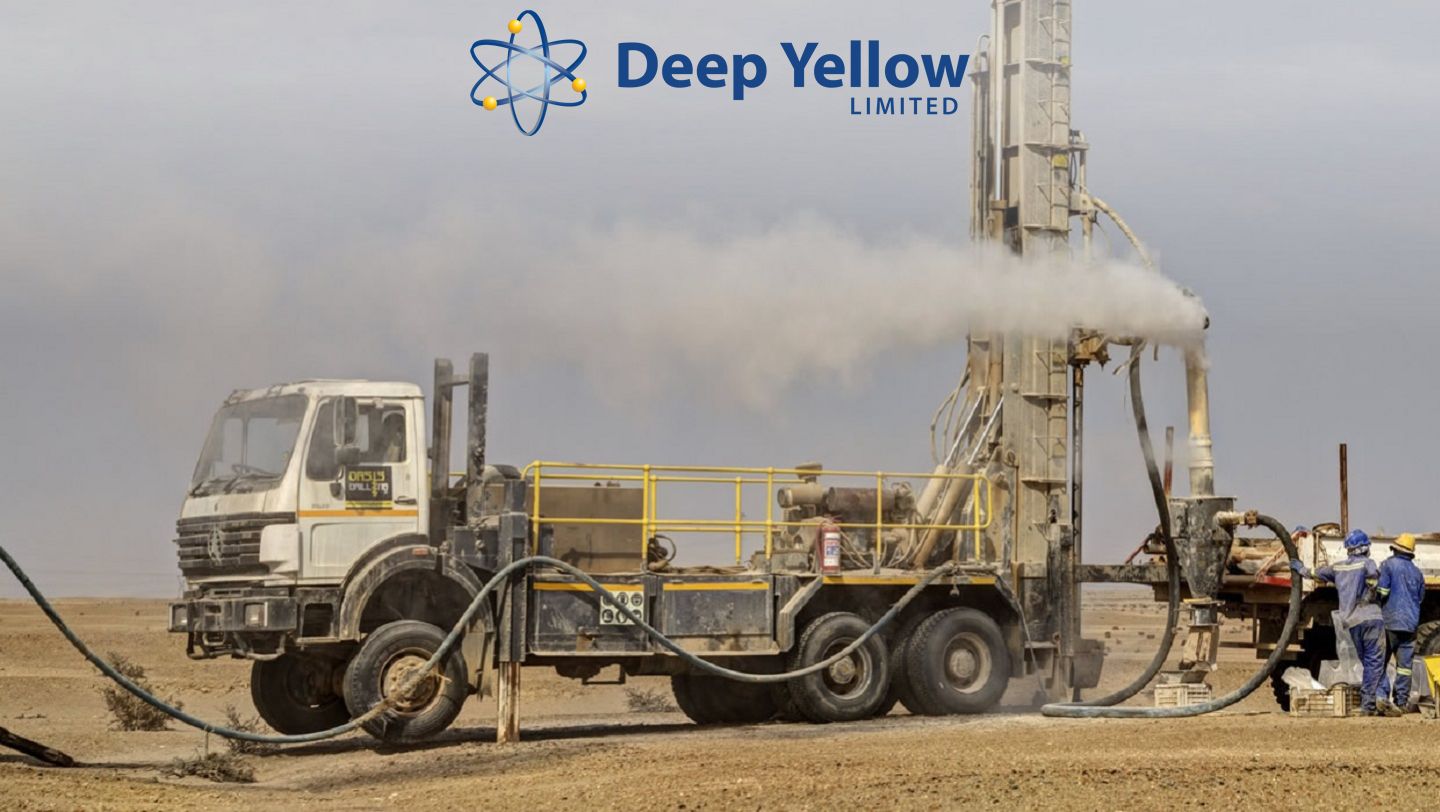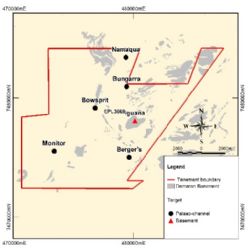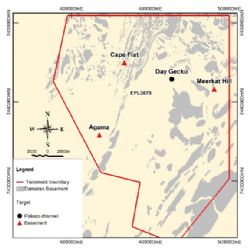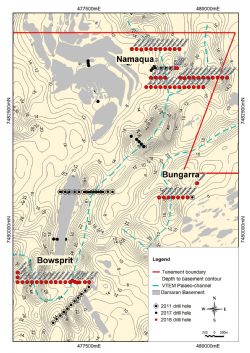
Nova JV Project - Scout Drilling Completed for 2018
Perth, Dec 19, 2018 AEST (ABN Newswire) - Deep Yellow Limited ( ASX:DYL) (
ASX:DYL) ( DYLLF:OTCMKTS) (Deep Yellow) advises the completion of the 2018 exploration drilling program carried out on its Nova Joint Venture project, Namibia (Nova JV) where Japanese Japan Oil, Gas and Metals National Corporation (JOGMEC) is earning a 39.5% interest on expenditure of A$4.5M. The drilling program started on 4 October and was suspended on 14 December 2018 to allow for the Christmas break.
DYLLF:OTCMKTS) (Deep Yellow) advises the completion of the 2018 exploration drilling program carried out on its Nova Joint Venture project, Namibia (Nova JV) where Japanese Japan Oil, Gas and Metals National Corporation (JOGMEC) is earning a 39.5% interest on expenditure of A$4.5M. The drilling program started on 4 October and was suspended on 14 December 2018 to allow for the Christmas break.
Highlights
- 2018 exploration drilling campaign completed on EPLs 3669 and 3670 with 122RC holes involving 4,874m.
o Targets focussed on calcretes within palaeochannels and alaskites in basement rocks.
- Drilling encountered encouraging results in palaeochannels on both EPLs.
o On EPL3670 uranium mineralisation was intersected in previously unexplored Day Gecko palaeochannel.
- At the Iguana Prospect on EPL 3669 four of seven drill holes intersected narrow uranium mineralisation including:
o TN0109RC 10m at 136ppm eU3O8 from 38m
14m at 184ppm eU3O8 from 74m
o TN0111RC 10m at 187ppm eU3O8 from 27m
The overall drilling campaign was designed to follow up encouraging drilling results from 2017 at the Namaqua palaeochannel and to test other channels in addition to various basement targets defined by the 2018 airborne spectrometric and magnetic survey. Four basement targets and six palaeochannels (including Namaqua) were targeted for this investigation. This exploration drilling totalled 4,874m and involved 122 RC holes. Figure 1 (see link below) shows the Nova JV tenements - EPLs 3669 and 3670. Figure 2 (see link below) shows the exploration target locations where drilling occurred in 2018. Results of drilling at Bungarra, Monitor and Berger's Channels along with basement targets at Cape Flat, Agama and Meerkat Hill recorded little or no mineralisation and drill hole locations for these areas are referred to in Appendix 1. Results of those targets where notable uranium mineralisation was encountered are in the Namaqua, Bowsprit and Day Gecko palaeochannel areas as well as the Iguana Basement target and are referred to in Figures 3 to 7(see link below). Appendix 1, Table 1 (see link below) lists all drill hole information.
Palaeochannel Targets
The reinterpretation of an earlier flown VTEM survey identified previously unknown palaeochannels on both EPL 3669 and 3670. Their geophysical similarities to other mineralised palaeochannels in the region and the identification of uranium mineralisation at Namaqua in 2017 encouraged continuing testing for calcrete-associated uranium mineralisation in these channels.
42 holes were completed at Namaqua following up on mineralisation identified in 2017. This was carried out on four lines for 1,140m (Fig. 3). The objective was to establish the extent of the palaeochannel calcrete-hosted mineralisation located in 2017 where three drill holes (TN035 to TN037) of drill section 7483400mN intercepted uranium mineralisation averaging 220ppm eU3O8 over 3.5m between depths of 18 to 23m.
This year's drilling identified weak uranium mineralisation in two drill holes (TN063RC and TN075RC) on two lines to the south of the 2017 discovery and extended the NW-SE trending mineralisation over a strike length of approximately 500m. Relatively low grades and narrow thicknesses were encountered, the best intersection at a 75ppm U3O8 cut-off is 3m @ 107 ppm in TN075RC. No mineralisation was identified on the northern drill section.
A gap remains between TN074RC and TN063RC where drilling could not be completed due to access problems. This gap will be infilled next year.
Figure 3 (see link below) shows the drill hole locations, interpreted palaeochannel and the Namaqua Prospect in the north of EPL
At the previously unexplored Day Gecko Channel (Fig 4 and 5) on EPL 3670, drilling totalling 11 holes for 107m intersected promising uranium mineralisation in hole CH065RC including 5m averaging 60ppm eU3O8 over 5m peaking at 320ppm which requires follow-up work.
20 holes were completed on the Bowsprit channel for 644m with an average hole depth of 32m. The holes tested the southern extension of the Namaqua channel. Two adjacent holes (TN101RC & 106RC) intersected 3m intervals of <100ppm U3O8 (see Appendix 1, Table 1 in link below).
All drill holes testing palaeochannel targets are detailed in Appendix 1, Tables 1 and 2 (see link below).
Basement Targets
Four targets were identified from airborne geophysics with detailed ground follow-up which indicated potential for uranium mineralisation in the basement rocks. A total of 17 drill holes for 1,648m was drilled on these targets. These holes are listed in Appendix 1, Table 2 (see link below) along with other drill hole information.
At Iguana on EPL3669 ground follow-up of an airborne radiometric anomaly identified three northwest trending sets of distinctly dark grey or black uranium bearing quartz veins. Seven holes for a total of 589m were completed to test these targets. Figure 6 (see link below) shows the drill hole locations with respect to the surface radiometric anomalies and Figure 7 (see link below) shows the drill hole cross-section through RC drill holes TN108 and 108.
Uranium mineralisation was recorded in four of the seven holes. The results are listed in Table 1 (see link below). Significant for future exploration is that the best intersections (10m @ 136ppm and 14m at 185ppm U3O8 in TN109RC, see Figure 7 in link below) were encountered in an area lacking a substantial surface radiometric response, indicating that increased mineralisation at depth can occur at this locality. Equivalent uranium values were determined from the fully calibrated Auslog down-hole gamma logging unit.
Drilling at Iguana has confirmed that substantial black quartz-vein hosted uranium mineralisation in three separate locations persists to depth. Limited follow-up drilling is planned to better define the potential of this mineralised system. The vein system seems to trend under cover of recent sediments towards the North-West. The extension of this needs to be tested by further drilling.
On EPL3670 three radiometric basement targets at Cape Flat, Agama and Meerkat Hill were investigated in detail. All 3 showed extensive surface uranium-associated radiometric anomalies varying in size from 400x100m (Cape Flat) to 1,500x300m (Agama and Meerkat Hill). Secondary uranium minerals were identified in the soil at all of them.
Three angled drill holes at each of Cape Flat and Agama and four holes at Meerkat Hill were aimed to undercut the radiometric anomalies. Results at all prospects were very similar as only weak, narrow uranium anomalism was encountered.
Figures 2 (see link below) shows the locations of all basement prospects and drill hole details including locations, depth and directions are listed in Appendix 1, Tables 1 and 2(see link below).
Conclusions
The follow-up drilling at Namaqua did not identify any economic uranium mineralisation at this stage, however the indication that previously unexplored (and unknown) palaeochannels are fertile and carry uranium mineralisation at Bowsprit and Day Gecko is regarded as a positive development. Although exploration drilling did not encounter economic uranium mineralisation, the identification of calcrete associated mineralisation within the palaeochannels in the Nova JV area is considered significant as this has confirmed the prospectively of the system of palaeochannels that has been identified. Further drilling is planned in 2019 to explore previously untested palaeochannels in the Nova JV area.
The north-western extension of Iguana which is blanketed by extensive cover will be explored by shallow bedrock drilling to isolate specific targets for follow-up RC drilling. RC drilling will also be used to continue to explore the newly identified prospective palaeochannels on EPLs 3669 and 3670 which remain untested.
To view tables and figures, please visit:
http://abnnewswire.net/lnk/J5T1HGX8
About Deep Yellow Limited
 Deep Yellow Limited (ASX:DYL) (OTCMKTS:DYLLF) is successfully progressing a dual-pillar growth strategy to establish a globally diversified, Tier-1 uranium company to produce 10+Mlb p.a.
Deep Yellow Limited (ASX:DYL) (OTCMKTS:DYLLF) is successfully progressing a dual-pillar growth strategy to establish a globally diversified, Tier-1 uranium company to produce 10+Mlb p.a.
The Company's portfolio contains the largest uranium resource base of any ASX-listed company and its projects provide geographic and development diversity. Deep Yellow is the only ASX company with two advanced projects - flagship Tumas, Namibia (Final Investment Decision expected in 1H/CY24) and MRP, Western Australia (advancing through revised DFS), both located in Tier-1 uranium jurisdictions.
Deep Yellow is well-positioned for further growth through development of its highly prospective exploration portfolio - ARP, Northern Territory and Omahola, Namibia with ongoing M&A focused on high-quality assets should opportunities arise that best fit the Company's strategy.
Led by a best-in-class team, who are proven uranium mine builders and operators, the Company is advancing its growth strategy at a time when the need for nuclear energy is becoming the only viable option in the mid-to-long term to provide baseload power supply and achieve zero emission targets.
Importantly, Deep Yellow is on track to becoming a reliable and long-term uranium producer, able to provide production optionality, security of supply and geographic diversity.
| ||
|








